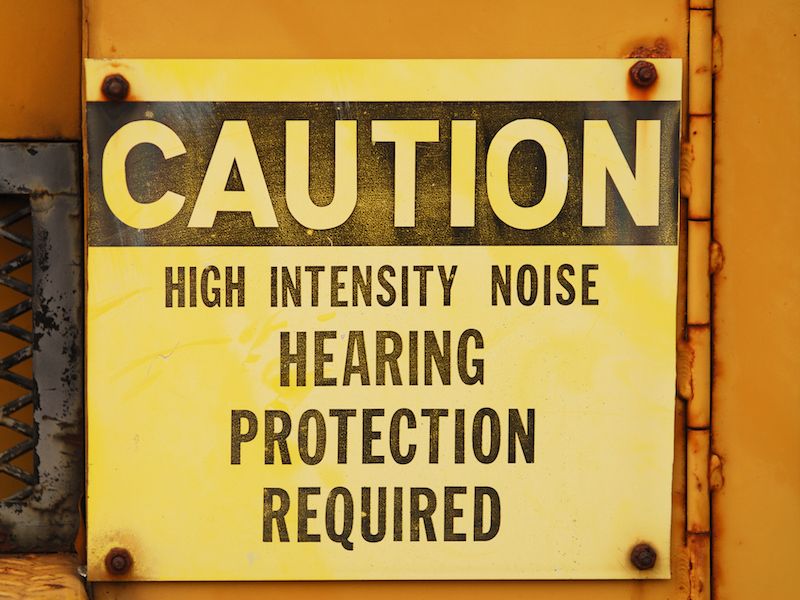
Realizing you need to protect your ears is one thing. Knowing when to protect your ears is a different story. It’s not as simple as, for example, recognizing when to wear sunblock. (Are you going outside? Is the sun out? You need to be wearing sunscreen.) Even knowing when you need eye protection is easier (Doing some hammering? Working with a saw or dangerous chemicals? Use eye protection).
It can feel like there’s a large grey area when dealing with when to wear ear protection, and that can be risky. Unless we have specific knowledge that some activity or place is dangerous we tend to take the easy road which is to avoid the issue entirely.
Risk Evaluations
In general, we’re not very good at assessing risk, especially when it comes to something as intangible as permanent hearing problems or hearing loss. To prove the point, here are some examples:
- A very loud rock concert is attended by person A. 3 hours is around how long the concert lasts.
- Person B owns a landscaping company. After mowing lawns all day, she goes home to quietly read a book.
- Person C works in an office.
You may believe the hearing hazard is higher for person A (let’s just call her Ann). Ann leaves the concert with her ears ringing, and she’ll spend the majority of the next day, struggling to hear herself talk. It seems reasonable to presume that Ann’s recreation was quite risky.
The noise that person B (let’s just call her Betty), is exposed to is not as loud. There’s no ringing in her ears. So it has to be safer for her hearing, right? Not really. Because Betty is riding that mower all day. The truth is, the damage accumulates a little at a time although they don’t ring out. If experienced every day, even moderately loud sounds can have a negative affect on your hearing.
What’s going on with person C (let’s call her Chris) is even more difficult to make sense of. The majority of people recognize that you need to protect your hearing while running machines such as a lawnmower. But although Chris has a relatively quiet job, her long morning commute through the city each day is quite loud. Additionally, although she works behind her desk all day, she listens to her music through earbuds. Is protection something she should consider?
When is it Time to be Concerned About Safeguarding Your Ears?
Generally, you need to turn the volume down if you have to raise your voice to be heard. And you should think about wearing earmuffs or earplugs if your surroundings are that noisy.
So to put this a little more clinically, you need to use 85dB as your limit. Sounds above 85dB have the ability, over time, to result in injury, so you need to think about using ear protection in those situations.
Many hearing specialists advise making use of a specialized app to keep track of noise levels so you will be cognizant of when the 85dB has been reached. These apps can tell you when the ambient sound is nearing a harmful level, and you can take suitable steps.
A Few Examples
Your phone might not be with you wherever you go even if you do get the app. So we might formulate a good standard with a few examples of when to protect our ears. Here we go:
- Exercise: Your morning cycling class is a good example. Or perhaps your daily elliptical session. You might consider wearing hearing protection to each. The high volume from trainers who use loud music and microphones for motivation, though it might be good for your heart rate, can be bad for your ears.
- Operating Power Tools: You recognize you will need hearing protection if you work every day in a factory. But how about the hobbyist building in his workshop? Most hearing professionals will suggest you wear hearing protection when working with power tools, even if it’s only on a hobbyist level.
- Listening to music with earbuds. OK, this doesn’t require protection but does require caution. Whether your music is going directly into your ears, how loud it’s playing, and how long you’re listening to it are all things you need to give consideration to. Noise-canceling headphones are a good choice to avoid having to turn the volume way up.
- Household Chores: We already discussed how something as straightforward as mowing the lawn, when done often enough, can require hearing protection. Cutting the grass is a great example of the type of household task that may cause harm to your hearing but that you probably don’t think about all that often.
- Commuting and Driving: Driving all day as an Uber or Lyft driver? Or maybe you’re just hanging around downtown for work or getting on the subway. The constant noise of city living, when experienced for 6-8 hours a day, can cause damage to your ears over the long haul, particularly if you’re cranking up your music to hear it over the din.
These illustrations may give you a good baseline. When in doubt, though, you should choose protection. Rather than leaving your ears exposed to future injury, in most situations, it’s better to protect your hearing. Protect today, hear tomorrow.